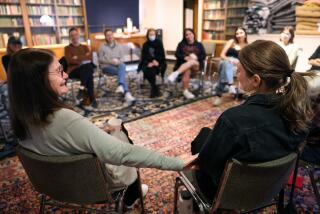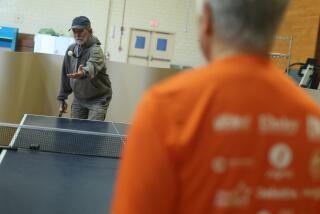Sharing Common Burden of Grief Eases Pain for Families of Suicides
- Share via
The Sargents were a close family. Toni and David and their three children did things together. Both parents were involved in the PTA. David was a member of the Torrance School Board.
When their only son killed himself on May 3, 1985, their world was turned upside down. Jonathan, 19, shot himself while his parents were out for the evening. His sister, Susie, then 17, heard the shot and found her brother’s body.
The entire family was devastated. Why hadn’t they understood the deepness of Jon’s depression? What could they have done to prevent his death? How could they handle the terrible grief, the sense of loss, of guilt and anger that they felt?
Established Fund
They decided to be open about the cause of Jon’s death, setting up the Jonathan Sargent Memorial Fund for Suicide Prevention.
They also worked with the Torrance Unified School District and the PTA to develop suicide prevention programs, starting at South High School, which Jon had attended.
This way of working out their grief made a few friends and family members uncomfortable. David Sargent said that his own mother and father would change the subject every time Jon’s name was mentioned.
“It’s denial. Period,” he said.
Then they heard about a Westside group called Survivors of Suicide, run by the Los Angeles Suicide Prevention Center. The couple went to a meeting conducted by a professional counselor from the center and a volunteer who also had lost a child to suicide.
‘Great Need’
“There is a great need for this kind of thing,” said Dr. Norman L. Farberow, co-founder of the suicide prevention center and a nationally recognized expert on the subject.
“There are 1,000 suicides yearly in Los Angeles County, about three a day,” he said. “It is estimated that there are between 5,000 and 7,500 people affected who are immediately related to the suicide (victim). There are several thousand people out there who might benefit from this kind of program.”
The survivors group was started in November, 1981. The idea came from a volunteer who, after the suicide of her brother, became a crisis-line volunteer. She wanted to talk to other people who had experienced the suicide of loved ones.
David Sargent recalled the first meeting he attended. “Everybody in the room had something terrible in common. Everyone had lost a near relative to suicide.
“That first meeting, I think, did two things. We suddenly got a gauge on the fact that even though we still felt so much pain, we had made a lot of progress from where we had been a few months earlier. We could tell that just from looking at the faces of some of the people in that room. The key feature was an instant feeling of empathy. They all knew why we were there.”
‘Able to Talk’
“The group had siblings, parents, spouses of victims,” Toni Sargent said. “There always seemed to be somebody who seemed in worse shape than you. There were siblings of victims who couldn’t understand their parents. By having (other) parents in the group, they were able to talk.
“They had come from all over the city. This was the only place they could come and talk,” she said.
“Suicide is one of the taboo subjects that has come out of the closet,” Farberow said. “It’s a mistaken notion that if you bring it up (to relatives), the other person will cry. They can talk about it and share it.”
The Sargents attended eight weekly sessions with a group of about 10 people. These sessions are intended as crisis intervention to deal with the initial shock.
They then were invited to meet monthly with a group of about 20 men and women, who also had completed the eight-week therapy sessions. Later, the Sargents became volunteer counselors for the center.
Survivors’ Meeting
At a recent meeting at Robertson Korean United Methodist Church at 1068 S. Robertson Blvd., led by Farberow and therapist Sam M. Heilig, participants ranged in age from about 25 to 60. Some were recently bereaved, while others had waited for years before deciding they needed to or were even able to discuss their grief.
“I think I need people to talk to, people willing to listen,” said a San Fernando Valley woman. “In the daytime I work in a school. You’re not going to talk about your son committing suicide. I sell real estate. How do you try to sell real estate and talk about your son committing suicide? My family won’t talk about it.
“I do have private counseling. They think differently. They tell me go on with your life. Do something meaningful every day. How do you find something meaningful when tomorrow your son would be 25?”
A couple from San Pedro said it was not quite three years ago that their 12-year-old daughter shot herself with her father’s gun.
The woman said that sessions with a therapist only compounded her husband’s depression, to the point that he talked about killing himself. Attending the monthly meetings has helped him, she said.
‘You Feel Comfortable’
Her husband nodded and said, “With this group you immediately feel comfortable. Everybody knows the experience.”
A 34-year-old Pasadena woman said she never thought she would be part of such a group. All that changed last summer, after her 31-year-old brother shot himself with a .22 rifle. He had been diagnosed as schizophrenic at age 27.
It’s time, she said, for people to stop thinking of suicide as something to be hidden, something shameful that taints the remaining family members.
“Incest and rape have come out of the closet. People talk about them. But no one wants to talk about mental illness or suicide,” she said.
She has told a few close friends about her brother’s death, but such talks make them uncomfortable, she said.
Friends for Life
“I think I have made friends in this group that I will have all my life,” she said.
Another woman in the group lost her brother five years ago. It is only now that she can talk about it, she said.
Others talked about their own mood swings, of sometimes feeling that they can get on with their lives and then suddenly plunging into depression.
Certain places, songs, items--almost anything can trigger a renewed sense of their loss, they said. They know, several said, that their loved ones took their own lives because they couldn’t live with the pain they felt. Now they are trying to ease their own pain.
A 29-year-old Mar Vista woman who lost her sister last December said, “This is the only place where it’s OK to be sad. Other people get impatient when you mention it.”
Suicide at 21
Her sister was 21 when she died of a drug overdose last December, after three years in therapy. She had not done as well in college as she thought she should. She had attempted suicide twice and each time was rushed to the hospital. Finally, she went to a motel where no one would find her until it was too late.
Her parents also are members of a survivors group.
“It seems to be really helpful for them. They talk about their problems and connect with other people. I love the group. Sometimes I go to a meeting and won’t even talk. But being there is comforting,” she said.
It is easier to talk to group members than to family and friends, she said. She plans to take training to handle calls on the Suicide Center’s hot line, so she can help prevent others from committing suicide.
The nonprofit Suicide Prevention Center is located at 1041 S. Menlo Ave. The office telephone number is (213) 386-5111. The number for the 24-hour suicide hot line is (213) 381-5111.
More to Read
Sign up for Essential California
The most important California stories and recommendations in your inbox every morning.
You may occasionally receive promotional content from the Los Angeles Times.













